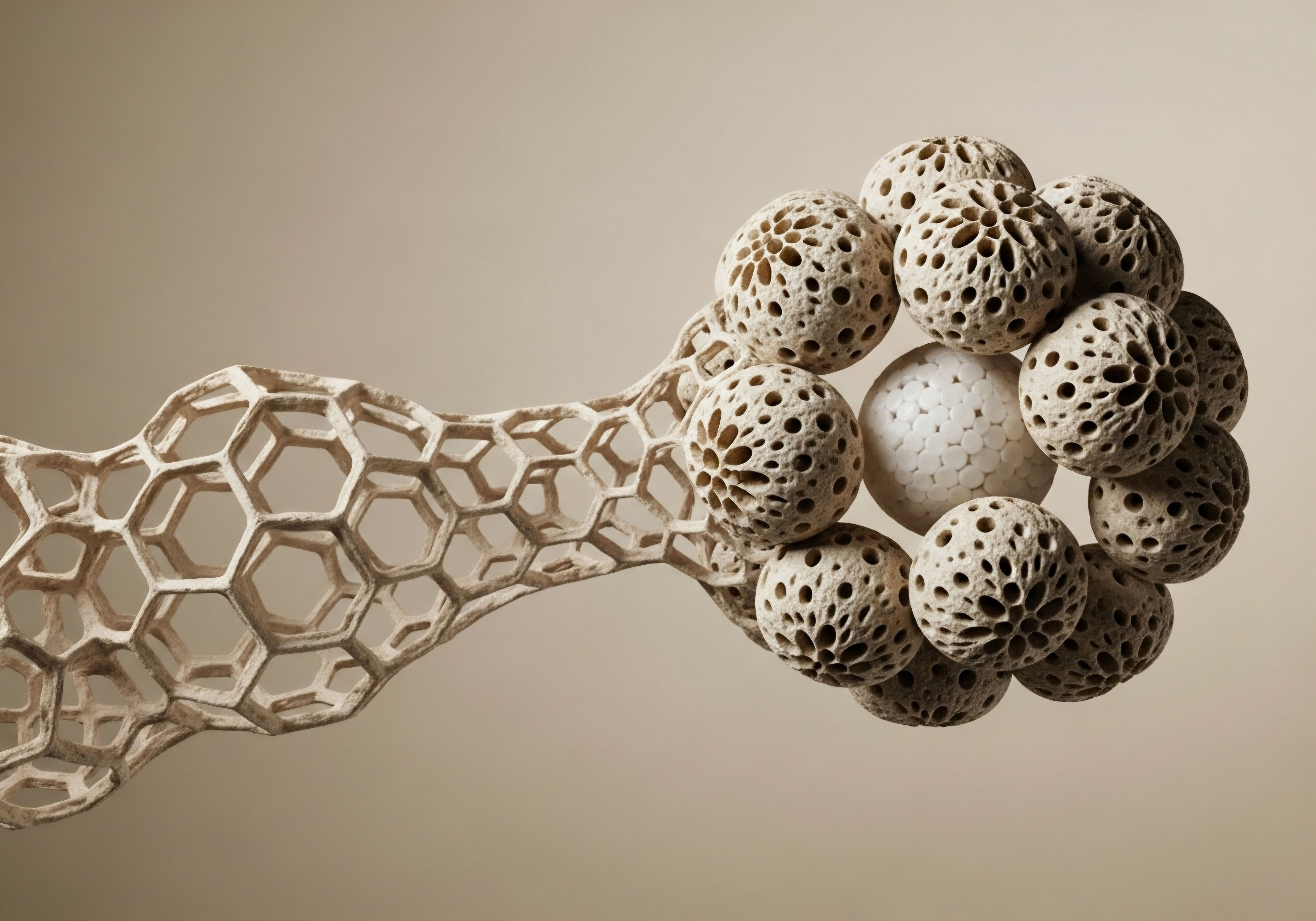

Fundamentals
Perhaps you have felt a subtle shift in your body’s rhythm, a quiet change in your energy levels, or a persistent sense that something within your biological systems is simply not operating as it once did. Many individuals experience these sensations, often dismissing them as inevitable aspects of aging or daily stress.
Yet, these feelings are frequently direct signals from your internal biochemical messengers, your hormones, indicating a need for careful attention. Understanding these signals marks the initial step toward reclaiming your vitality and function.
The human body functions as a complex network, with the endocrine system serving as its central communication system. This system comprises glands that produce and release hormones, which act as chemical messengers. These messengers travel through the bloodstream, influencing nearly every physiological process, from growth and metabolism to mood and reproductive health. When external factors, such as physical activity, introduce a controlled disruption to this internal balance, the endocrine system responds by adjusting hormone production to restore equilibrium.

How Physical Activity Shapes Hormonal Balance
Physical activity is a potent modulator of hormonal activity. Regular, moderate engagement in exercise can stimulate the endocrine system, prompting an increase in the production of various hormones. This interaction is not a simple, linear cause-and-effect; rather, it involves intricate feedback loops and adaptive responses. For instance, exercise can influence the sensitivity of cells to hormones, meaning the body can use its existing hormonal resources more effectively.
Physical activity acts as a significant regulator of the body’s hormonal systems, promoting adaptive responses that support overall physiological balance.
Consider the hormone cortisol, often associated with stress. While acute, intense exercise can temporarily elevate cortisol levels, chronic, excessive training without adequate recovery can lead to sustained high levels, potentially disrupting other hormonal processes, including the menstrual cycle in women. Conversely, moderate, consistent physical activity can help regulate cortisol, contributing to improved stress management and mental well-being.
Another key player is insulin, a hormone produced by the pancreas that manages blood glucose. Exercise enhances insulin sensitivity, allowing cells to absorb glucose more efficiently from the bloodstream. This effect is particularly beneficial for metabolic health, aiding in blood sugar control and reducing the risk of conditions linked to insulin resistance. Both resistance training and aerobic exercise have demonstrated positive effects on insulin sensitivity.

The Hormone Triad ∞ Exercise, Nutrition, and Rest
Hormonal health is not solely dependent on physical activity. It exists within a broader framework, often referred to as the “hormone triad,” which includes exercise, nutrition, and rest. Each element plays a distinct, yet interconnected, role in maintaining optimal endocrine function. Neglecting any one component can undermine the benefits gained from the others. For example, rigorous exercise without sufficient caloric intake or restorative sleep can place the body under undue stress, potentially hindering hormone production and overall recovery.
This holistic perspective underscores that personalized wellness protocols must consider all aspects of an individual’s lifestyle. A well-structured exercise regimen, combined with a nutrient-dense diet and adequate sleep, creates a supportive environment for the endocrine system to operate at its best. This integrated approach helps the body adapt positively to physical demands, promoting a more stable and responsive hormonal landscape over time.


Intermediate
Moving beyond the foundational understanding, we can explore how specific exercise protocols can strategically complement hormonal interventions. When individuals engage in targeted physical activity, they are not merely burning calories; they are sending precise biochemical signals throughout their systems. These signals can amplify the positive outcomes of hormonal optimization protocols, creating a synergistic effect that helps restore physiological balance.

Optimizing Testosterone Levels with Exercise
Testosterone, a primary sex hormone in men and a vital component of female health, influences muscle growth, bone density, mood, and libido. While hormonal optimization protocols like Testosterone Replacement Therapy (TRT) directly address deficiencies, specific exercise types can enhance the body’s response.
Resistance training, such as lifting weights or using resistance bands, places mechanical stress on muscles. This stress signals the body to produce more testosterone to aid in muscle repair and growth. Studies indicate that exercises involving large muscle groups, like squats and deadlifts, tend to elicit the most significant acute increases in testosterone.
The intensity and volume of resistance exercise also play a role; moderate to high intensity with shorter rest periods between sets can lead to more pronounced acute hormonal responses.
Resistance training, particularly with compound movements, can acutely stimulate testosterone production, complementing hormonal support.
For men undergoing Testosterone Replacement Therapy, a typical protocol might involve weekly intramuscular injections of Testosterone Cypionate (200mg/ml). This is often combined with Gonadorelin, administered twice weekly via subcutaneous injections, to help maintain natural testosterone production and preserve fertility. Anastrozole, an oral tablet taken twice weekly, may also be included to manage estrogen conversion and mitigate potential side effects. In some cases, Enclomiphene may be added to support luteinizing hormone (LH) and follicle-stimulating hormone (FSH) levels.
For women, testosterone protocols differ significantly. Pre-menopausal, peri-menopausal, and post-menopausal women experiencing symptoms such as irregular cycles, mood changes, hot flashes, or reduced libido may receive Testosterone Cypionate, typically 10 ∞ 20 units (0.1 ∞ 0.2ml) weekly through subcutaneous injection. Progesterone is often prescribed based on menopausal status. Pellet therapy, offering long-acting testosterone, can also be an option, with Anastrozole considered when appropriate to manage estrogen levels.
While exercise can cause temporary surges in testosterone, these acute elevations are generally not sustained beyond an hour or so post-workout. The long-term impact of exercise alone on basal (resting) testosterone levels is less clear and shows variability across studies, particularly in lean, younger individuals. However, in overweight or obese men, exercise, especially when combined with weight reduction, has shown a more consistent association with increased basal testosterone levels.

Exercise and Estrogen Balance
Estrogen levels are highly sensitive to physical activity and nutritional status. For women, maintaining a healthy estrogen balance is vital for reproductive health, bone density, and mood regulation. Aerobic exercise, such as walking, running, or swimming, can contribute to this balance by supporting the body’s detoxification processes and potentially influencing estrogen metabolism.
One study demonstrated that 150 minutes of moderate-to-vigorous aerobic exercise per week over 16 weeks led to beneficial changes in estrogen metabolism in healthy premenopausal women, specifically increasing the ratio of 2-hydroxyestrone (2-OHE1) to 16α-hydroxyestrone (16α-OHE1). This shift is considered favorable in the context of breast health. However, research on exercise and estrogen metabolism can be complex, with some studies showing conflicting results, possibly due to variations in methodology, participant characteristics, and the specific estrogen metabolites measured.
The type and timing of exercise can also be tailored to a woman’s menstrual cycle. During menstruation, when hormone levels are typically lower, engaging in lower-intensity activities like walking or yoga may be more suitable. Conversely, during ovulation, when energy levels are often higher, incorporating high-intensity interval training (HIIT) or resistance training can be more effective.

Growth Hormone Peptide Therapy and Exercise Synergy
Growth hormone (GH) plays a significant role in muscle and bone growth, fat metabolism, and immune system support. Certain peptides are designed to stimulate the body’s natural production of growth hormone. These include Sermorelin, Ipamorelin/CJC-1295, Tesamorelin, Hexarelin, and MK-677. These therapies are often sought by active adults and athletes aiming for anti-aging benefits, muscle gain, fat loss, and improved sleep quality.
Exercise itself is a powerful stimulus for GH production, particularly high-intensity strength or cardiorespiratory activities. The synergy between growth hormone peptide therapy and targeted exercise protocols is compelling. By stimulating endogenous GH release through peptides while simultaneously engaging in physical activity that naturally boosts GH, individuals may experience enhanced outcomes related to tissue repair, muscle protein synthesis, and metabolic efficiency.
Other targeted peptides, such as PT-141 for sexual health and Pentadeca Arginate (PDA) for tissue repair, healing, and inflammation, can also be integrated into a comprehensive wellness plan. While direct research on the exercise synergy with these specific peptides is still developing, the general principle of supporting systemic health through physical activity remains relevant.
A balanced exercise routine, incorporating both strength training and aerobic activity, is generally recommended for optimal hormonal health. This balance helps to prevent overtraining, which can lead to counterproductive hormonal responses, such as elevated cortisol and suppressed testosterone. Consistency, adequate nutrition, and sufficient rest are paramount to maximizing the benefits of exercise in conjunction with hormonal interventions.
| Exercise Type | Primary Hormonal Impact | Benefits |
|---|---|---|
| Resistance Training | Acute testosterone, growth hormone, insulin sensitivity | Muscle growth, bone density, strength, metabolic health |
| Aerobic Exercise | Estrogen metabolism, insulin sensitivity, cortisol regulation | Cardiovascular health, weight management, mood regulation |
| High-Intensity Interval Training (HIIT) | Acute testosterone, growth hormone, endorphins, insulin sensitivity | Time efficiency, fat reduction, mood elevation |
| Low-Intensity Exercise (e.g. Yoga) | Cortisol reduction, hormonal regulation via gland stimulation | Stress management, flexibility, mental well-being |
It is important to approach exercise as a tool for physiological recalibration, not merely a means to an end. The body’s response to physical activity is highly individual, influenced by age, fitness level, body composition, and underlying health conditions. Therefore, personalized exercise protocols, developed in consultation with healthcare professionals, are essential to ensure safety and efficacy when combined with hormonal interventions.


Academic
A deep exploration into the interplay between targeted exercise protocols and hormonal intervention outcomes requires a systems-biology perspective, acknowledging the intricate communication networks within the human body. The endocrine system, far from operating in isolation, is deeply integrated with metabolic pathways, neurological function, and cellular signaling. Understanding these connections provides a more complete picture of how physical activity can truly optimize hormonal support.

The Hypothalamic-Pituitary-Gonadal Axis and Exercise
The Hypothalamic-Pituitary-Gonadal (HPG) axis represents a central regulatory pathway for reproductive and hormonal function. The hypothalamus releases gonadotropin-releasing hormone (GnRH), which stimulates the pituitary gland to secrete luteinizing hormone (LH) and follicle-stimulating hormone (FSH). These gonadotropins then act on the gonads (testes in men, ovaries in women) to produce sex hormones like testosterone and estrogen.
Exercise, particularly resistance training, can acutely influence this axis. Studies have shown that heavy resistance exercise can lead to immediate, transient increases in circulating testosterone concentrations. While the exact mechanisms for this acute rise are still under investigation, some research suggests it may involve a catecholamine surge and direct testicular stimulation, rather than solely LH pulse changes. However, these acute elevations are typically not sustained, returning to baseline within minutes to an hour post-exercise.
The long-term impact of exercise on basal HPG axis function and resting sex hormone levels is more complex and variable. Chronic, intense endurance training, for example, has sometimes been associated with lower basal testosterone levels in men, potentially due to exercise-induced stress leading to hypothalamic-pituitary suppression.
Conversely, resistance training, especially in older or obese individuals, has shown some promise in increasing resting testosterone, often linked to reductions in fat mass and improved metabolic health. This suggests that the systemic metabolic improvements from exercise may indirectly support HPG axis function over time.

Metabolic Pathways and Hormonal Interconnectedness
Hormones and metabolic processes are inextricably linked. Exercise profoundly impacts metabolic pathways, which in turn influence hormonal signaling. A prime example is the effect of exercise on insulin sensitivity. Regular physical activity, both aerobic and resistance-based, enhances the responsiveness of cells to insulin, allowing for more efficient glucose uptake and utilization. This improvement in insulin sensitivity is critical, as insulin resistance can contribute to hormonal imbalances, including reduced testosterone levels and altered estrogen metabolism.
Another significant metabolic connection involves growth hormone (GH). Exercise, particularly high-intensity activities, is a potent physiological stimulus for GH secretion. GH, in turn, influences fat metabolism, protein synthesis, and glucose regulation. The use of growth hormone-releasing peptides (GHRPs) and growth hormone-releasing hormone (GHRH) analogues, such as Sermorelin or Ipamorelin/CJC-1295, aims to amplify this natural GH pulsatility.
When combined with exercise, these peptides can theoretically enhance the body’s anabolic and lipolytic responses, supporting muscle accretion and fat reduction.
The liver’s role in hormone metabolism cannot be overstated. It processes and inactivates hormones, and its efficiency can be influenced by metabolic health. Exercise, by improving liver health and reducing hepatic fat accumulation, can indirectly support balanced hormone clearance and synthesis.
For instance, aerobic exercise has been shown to influence estrogen metabolism by promoting the production of less genotoxic estrogen metabolites, such as 2-hydroxyestrone (2-OHE1), over more potentially harmful ones like 16α-hydroxyestrone (16α-OHE1). This shift in metabolic pathways is a critical aspect of exercise’s protective effects against certain hormone-sensitive conditions.

Neurotransmitter Function and Hormonal Regulation
The brain, through its production of neurotransmitters, plays a substantial role in regulating the endocrine system. Physical activity directly influences neurotransmitter levels, creating a feedback loop that impacts hormonal balance and overall well-being. For example, exercise increases the levels of serotonin and dopamine, neurotransmitters associated with mood regulation and pleasure. These changes can indirectly support hormonal equilibrium by reducing stress-related cortisol secretion and improving sleep quality, both of which are critical for endocrine health.
The stress response, mediated by the hypothalamic-pituitary-adrenal (HPA) axis, is tightly regulated by both physical and psychological stressors. While acute exercise activates the HPA axis, leading to a temporary rise in cortisol, regular, moderate exercise can improve the HPA axis’s adaptive capacity, leading to a more resilient stress response. Chronic overtraining, conversely, can dysregulate the HPA axis, resulting in chronically elevated cortisol, which can suppress sex hormone production and impair recovery.
Targeted exercise protocols, when integrated with hormonal interventions, can therefore operate on multiple physiological levels. They not only influence the direct production and metabolism of hormones but also optimize the cellular and systemic environments in which these hormones function. This comprehensive approach acknowledges that true hormonal optimization extends beyond mere replacement; it involves recalibrating the body’s intrinsic regulatory systems.
| Intervention Protocol | Primary Goal | Exercise Synergy | Key Considerations |
|---|---|---|---|
| TRT ∞ Men | Restore testosterone levels, address hypogonadism symptoms. | Resistance training (heavy, compound movements) to enhance acute testosterone response and muscle anabolism. Aerobic exercise for metabolic health. | Avoid overtraining; ensure adequate recovery to prevent cortisol spikes. Monitor HPG axis response with Gonadorelin. |
| TRT ∞ Women | Balance female hormones, address low libido, mood changes, bone density. | Resistance training for muscle tone and bone density. Aerobic exercise for estrogen metabolism. Cycle-syncing exercise intensity. | Careful dosing of testosterone (0.1-0.2ml weekly). Progesterone use based on menopausal status. |
| Post-TRT/Fertility (Men) | Restore natural testosterone production, support fertility. | Moderate exercise to support overall health and HPG axis recovery. Avoid intense, prolonged endurance exercise that may suppress the axis. | Gonadorelin, Tamoxifen, Clomid, Anastrozole used to stimulate endogenous production. |
| Growth Hormone Peptide Therapy | Anti-aging, muscle gain, fat reduction, sleep improvement. | High-intensity resistance and interval training to naturally stimulate GH release, amplifying peptide effects. | Peptides like Sermorelin, Ipamorelin/CJC-1295, Tesamorelin, Hexarelin, MK-677 work synergistically with exercise. |
| Other Targeted Peptides | Sexual health (PT-141), tissue repair/inflammation (PDA). | Exercise supports systemic health, blood flow, and tissue recovery, creating an optimal environment for peptide action. | Integrate exercise that supports the specific therapeutic aim (e.g. pelvic floor exercises for sexual health, low-impact for tissue repair). |
The scientific literature, while sometimes presenting varied outcomes due to methodological differences, consistently points to exercise as a powerful adjunct to hormonal interventions. The precise mechanisms by which exercise influences hormone production, receptor sensitivity, and metabolic clearance are still areas of active research. However, the overarching principle remains ∞ a body that moves optimally is a body better equipped to produce, utilize, and regulate its own biochemical messengers, thereby enhancing the efficacy of any external hormonal support.
- Hormonal Feedback Loops ∞ Exercise can influence the sensitivity of hormonal receptors, meaning the body’s cells become more responsive to existing hormone levels.
- Metabolic Efficiency ∞ Physical activity improves glucose metabolism and insulin sensitivity, which directly impacts the balance of other hormones, including sex steroids.
- Neuroendocrine Modulation ∞ Exercise affects neurotransmitter synthesis and release, which in turn influences the HPA and HPG axes, impacting stress response and reproductive hormones.
- Inflammation Reduction ∞ Regular, appropriate exercise can reduce systemic inflammation, a factor known to negatively influence hormonal balance and metabolic function.

References
- Hackney, A. C. & Lane, A. R. (2015). Exercise and the Regulation of Endocrine Hormones. Prog Mol Biol Transl Sci, 135, 293-311.
- Riches, E. (2023). How Does Exercise Impact Our Hormones? Forth.
- Mather Hospital. (n.d.). Exercise and hormones.
- Bennett, N. E. (2025). Can Physical Activity Affect Testosterone? Northwestern Medicine.
- Riachy, R. McKinney, K. & Tuvdendorj, D. R. (2020). Various Factors May Modulate the Effect of Exercise on Testosterone Levels in Men. J Funct Morphol Kinesiol, 5(4), 81.
- Kraemer, W. J. Häkkinen, K. Newton, R. U. Nindl, B. C. Volek, J. S. McCormick, M. & Evans, W. J. (1999). Effects of heavy-resistance training on hormonal response patterns in younger vs. older men. Journal of Applied Physiology, 87(3), 982-992.
- Smith, A. J. Phipps, W. R. Thomas, W. Schmitz, K. H. & Kurzer, M. S. (2013). The Effects of Aerobic Exercise on Estrogen Metabolism in Healthy Premenopausal Women. Cancer Epidemiol Biomarkers Prev, 22(5), 756 ∞ 764.
- The Marion Gluck Clinic. (n.d.). The Best Way to Exercise to Balance Hormones.

Reflection
As you consider the intricate connections between physical activity and your body’s hormonal systems, perhaps a new understanding of your own health journey begins to form. The knowledge presented here is not merely a collection of facts; it is a lens through which to view your personal biological landscape. Recognizing that your body communicates through a complex symphony of chemical messengers empowers you to become a more active participant in your well-being.
The path to reclaiming vitality is deeply personal, requiring a thoughtful consideration of your unique physiological responses. This exploration of exercise and hormonal interventions serves as a starting point, a foundation upon which to build a truly personalized protocol. Your body possesses an innate capacity for balance and adaptation; providing it with the right signals, through movement, nutrition, and rest, can unlock its full potential.

What Does Personalized Wellness Truly Mean?
Personalized wellness extends beyond generic advice. It involves a continuous dialogue between your lived experience, objective biological markers, and evidence-based strategies. This approach acknowledges that while scientific principles are universal, their application must be tailored to the individual.
Consider how your daily choices, from the intensity of your workouts to the quality of your sleep, send messages to your endocrine system. Each decision contributes to the ongoing conversation within your body. By consciously shaping these inputs, you can influence your hormonal landscape, moving closer to a state of optimal function and sustained well-being. This journey is a testament to the body’s remarkable ability to respond and adapt when given the precise support it requires.



